Architecture(s) et
application(s) Web
CSC4101 - Génération de pages22/08/2025
Architecture(s) et
application(s) Web
CSC4101 - Génération de pages22/08/2025
22/08/2025
Plan de la séance
Objectifs de cette séance :
- Ressources, Pages, Vues
- Gabarits (templates)
- Outils Symfony
Pages Web ?
Récupération de représentation de ressources par HTTP
- CRUD :
- Create
- Read / Retrieve
- Update
- Delete
- on s’intéresse dans un premier temps à la consultation d’une
(représentation de) ressource : méthode
GET(+ URL) - on verra la modification ultérieurement.
Représentation de ressource
Ressource Web : objet d’une requête
Exemple : page, document vidéo, formulaire, …
- Représentation
- document (statique)
- ou vue d’une application (dynamique)
Questions philosophiques
- Ressource == Représentation ?
- Représentation == Visualisation réalisée par le client HTTP ?
Important pour raisonement (Web sémantique). Hors sujet pour l’instant.
Vues d’une application
La vue représente un état d’une application interactive, pour l’utilisateur
Patron de conception M V C (Modèle, Vues, Contrôleur)
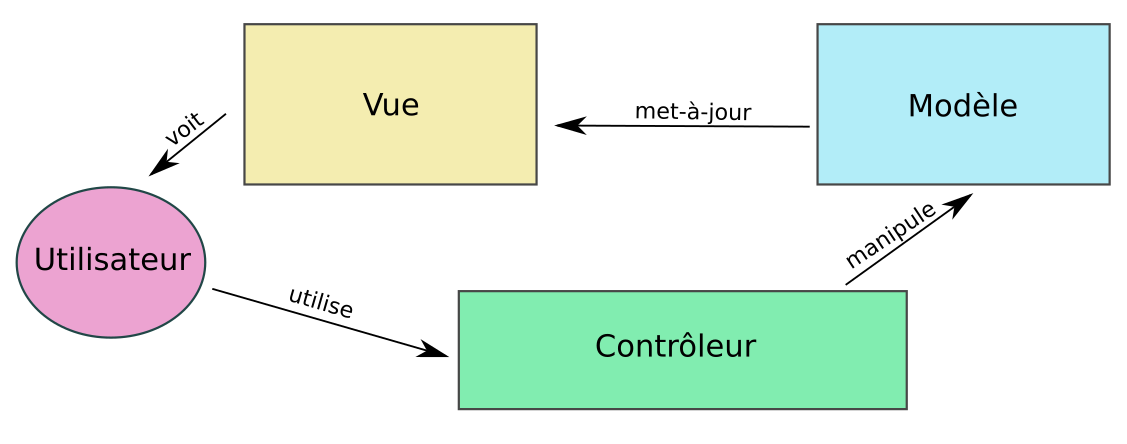
Modèle déjà vu avec Doctrine. Controleur déjà vu pour programmation événementielle.
Contenu d’une page Web
Page Web = représentation d’une vue de l’application (affichable dans un navigateur)
Visualisation d’une page (ressourceà contenant différentes ressources
- document HTML principal
- ressources additionnelles : images, feuilles de style, scripts, …
Hypertexte : proviennent pas toutes du même serveur HTTP (requêtes supplémentaires)
Recette (classique) de fabrication d’une page
- Générer une représentation d’une ressource gérée par
l’application
- HTML (construit côté serveur)
- transmise dans la réponse HTTP
- Avoir prévu :
- ressources statiques complémentaires : CSS, Images, JavaScript, …
- outils d’adaptation dynamique (exécution CSS et JavaScript côté client)
Construction de la page à visualiser
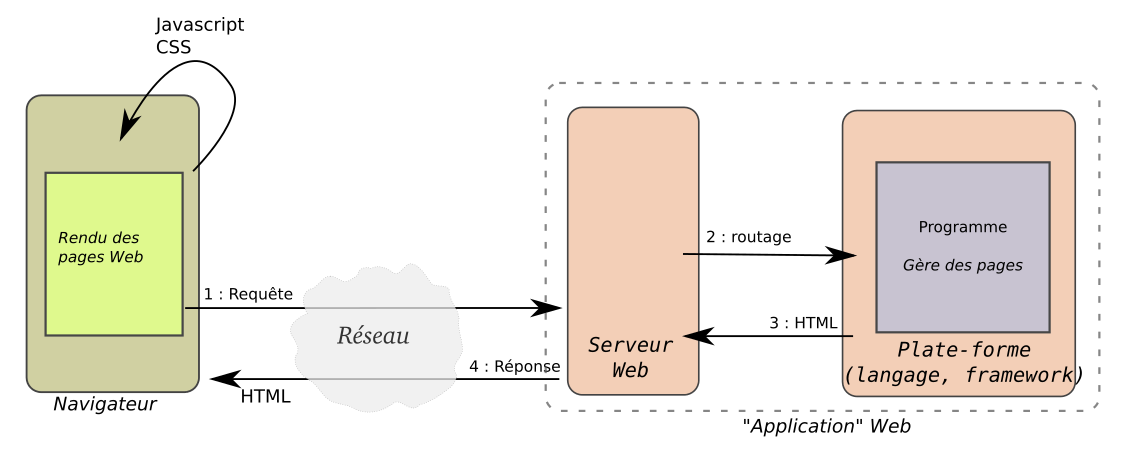
Fabriquer la page
- soit côté serveur
- générer du HTML qui transite vers le navigateur dans la réponse à une requête HTTP
- soit côté client
- un programme Javascript s’exécute dans le contexte d’une page chargée par le navigateur, et construit du DOM en mémoire pour enrichir cette page (et déclenche d’autres requêtes HTTP)
Dans ce cours, principalement 1ère option (application Web « classique »)
Langages standards pour pages Web
Séparation structure / mise en forme
- HTML : structure de la page, texte, méta-données
- CSS : mise en forme
HTML
HyperText Markup Language
Structure
Arbre sections, sous-section (plan document textuel), visible :
<body><h1>...</h1><h2>...</h2><p>...</p>
<h1>...</h1>
</body>
mise en forme « par défaut » par navigateur
- Structure additionnelle : sections / zones (pas forcément visible,
par défaut, mais modifiables par le CSS) :
<div>...</div><span>...</span>
Balises sémantiques
<article><aside><details><figcaption><figure><footer><header><main><mark><nav><section><summary><time>
| <header> | |
| <nav> | |
| <aside> | <section> |
| <article> | |
| <footer> | |
Quelques balises
Listes à puces :
<ul>
<li> ... </li>
<li> ... </li>
</ul>
Lien vers une autre ressource :
<a href="/todo/42">Coder en HTML</a>
Formulaires
Soumission de données pour les applications : génère des requêtes HTTP vers des ressources.
-> séances suivantes
Code source
Examiner le code source dans le navigateur
Ctrl U !
Produire du HTML avec PHP
« affichage » d’HTML sur la sortie standard du programme
echo "<html>...</html>";ou
print("<html>...</html>");- Mieux : Bibliothèque de génération HTML
- Gabarits (Templates)
</generation_pages>
Plan de la séance
- Génération de pages
- Gabarits (templates)
- Outils Symfony
Patron / gabarit
En couture :
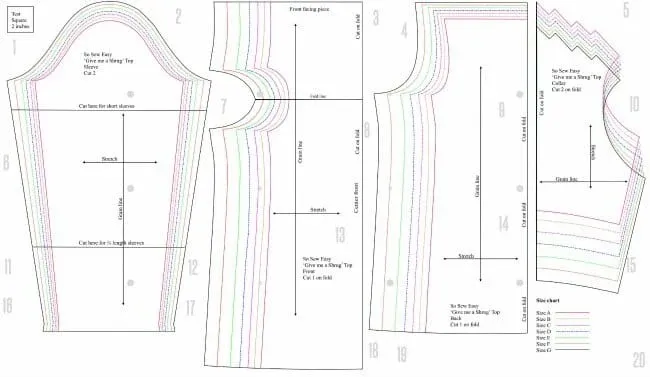
Génération du HTML grâce aux gabarits
- Page construite à partir :
- structure de la page : gabarit (statique)
- données générées par le programme (dynamiques)
- Génération HTML par moteur de templates
Exemple
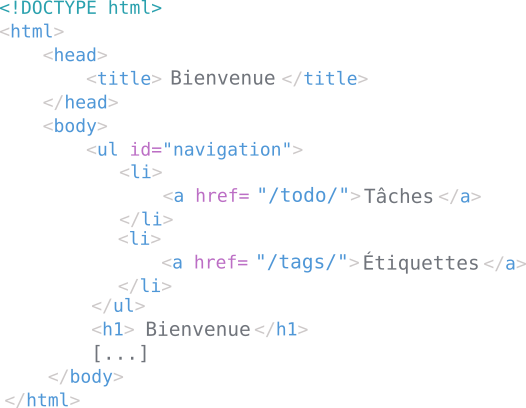
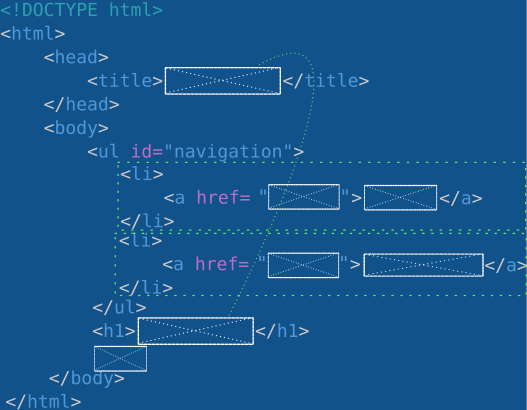
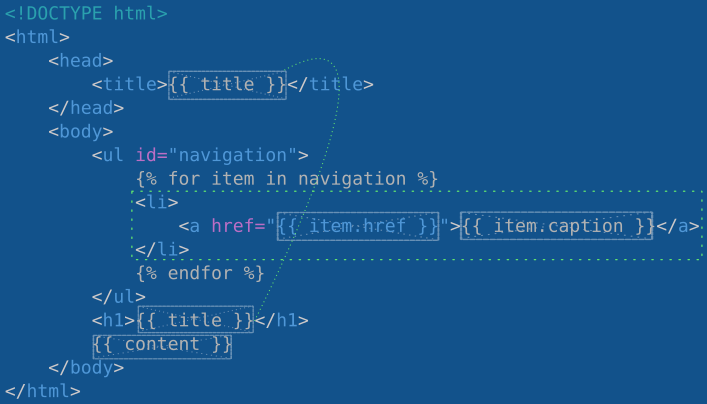
Moteur de gabarits Twig

- Moteur de templates pour PHP, utilisé dans Symfony
- Utilisable seul
- Syntaxe inspiré de Jinja (populaire en Python, avec Django)
Exemple : liens d’un menu
Résultat souhaité (liste à puces) :
<!DOCTYPE html>
<html>
<head>
<title>Ma page</title>
</head>
<body>
<ul id="navigation">
<li><a href="/todo/">Tâches</a></li>
<li><a href="/tag/">Étiquettes</a></li>
<li><a href="/project/">Projets</a></li>
</ul>
<h1>Ma page</h1>
Salut le monde
</body>
</html>
Gabarit de base d’un élément de menu
Motif à répéter : élément de liste à puce (<li>) contenant une balise
de lien (<a href="...">...</a>)
Données : couple [href, caption]
<li>
<a href="{{ href }}">
{{ caption }}
</a>
</li>
Données à injecter
Tableau de couples [href, caption]
array(
array('href' => "/todo/", 'caption' => "Tâches"),
array('href' => "/tag/", 'caption' => "Étiquettes"),
array('href' => "/project/", 'caption' => "Projets")
);
Gabarit de page complet
<!DOCTYPE html>
<html>
<head>
<title>{{ title }}</title>
</head>
<body>
<ul id="navigation">
{% for item in navigation %}
<li><a href="{{ item.href }}">{{ item.caption }}</a></li>
{% endfor %}
</ul>
<h1>{{ title }}</h1>
{{ content }}
</body>
</html>
Données complètes
array(
'title' => "Ma page",
'navigation' => array(
array('href' => "/todo/", 'caption' => "Tâches"),
array('href' => "/tag/", 'caption' => "Étiquettes"),
array('href' => "/project/", 'caption' => "Projets")
),
'content' => "Salut le monde"
);
Résultat HTML généré
<!DOCTYPE html>
<html>
<head>
<title>Ma page</title>
</head>
<body>
<ul id="navigation">
<li><a href="/todo/">Tâches</a></li>
<li><a href="/tag/">Étiquettes</a></li>
<li><a href="/project/">Projets</a></li>
</ul>
<h1>Ma page</h1>
Salut le monde
</body>
</html>
HTML nettoyé et valide (ça peut aider)
Syntaxe Twig
- Variable
{{ var }}- Instruction
{% ... %}- foreach :
for i in, - if :
if/endif, block- …
- foreach :
- Commentaire
{# ... #}(différent de<!-- ... -->: commentaire HTML)
Programmer en Twig
- Programmation simple
- Mélange HTML et instructions Twig
- Algorithmique basique : boucles, conditionnelles
- syntaxe à la Python
- Pattern matching (filtrage par motif)
- Structuration en motifs factorisables (va en général de pair avec les CSS)
Exemple code d’appel à Twig
<?php
require_once("../lib/Twig/Autoloader.php" );
Twig_Autoloader::register();
$loader = new Twig_Loader_Filesystem('../templates/');
$twig = new Twig_Environment($loader);
$data = array('title' => "Ma page"
'navigation' => array(
array('href' => "/todo/", 'caption' => "Tâches"),
array('href' => "/tag/", 'caption' => "Étiquettes"),
array('href' => "/project/", 'caption' => "Projets")
),
'content' => "Salut le monde");
echo $twig->render('home.html.twig', $data);
Conception des gabarits
Repérer des blocs
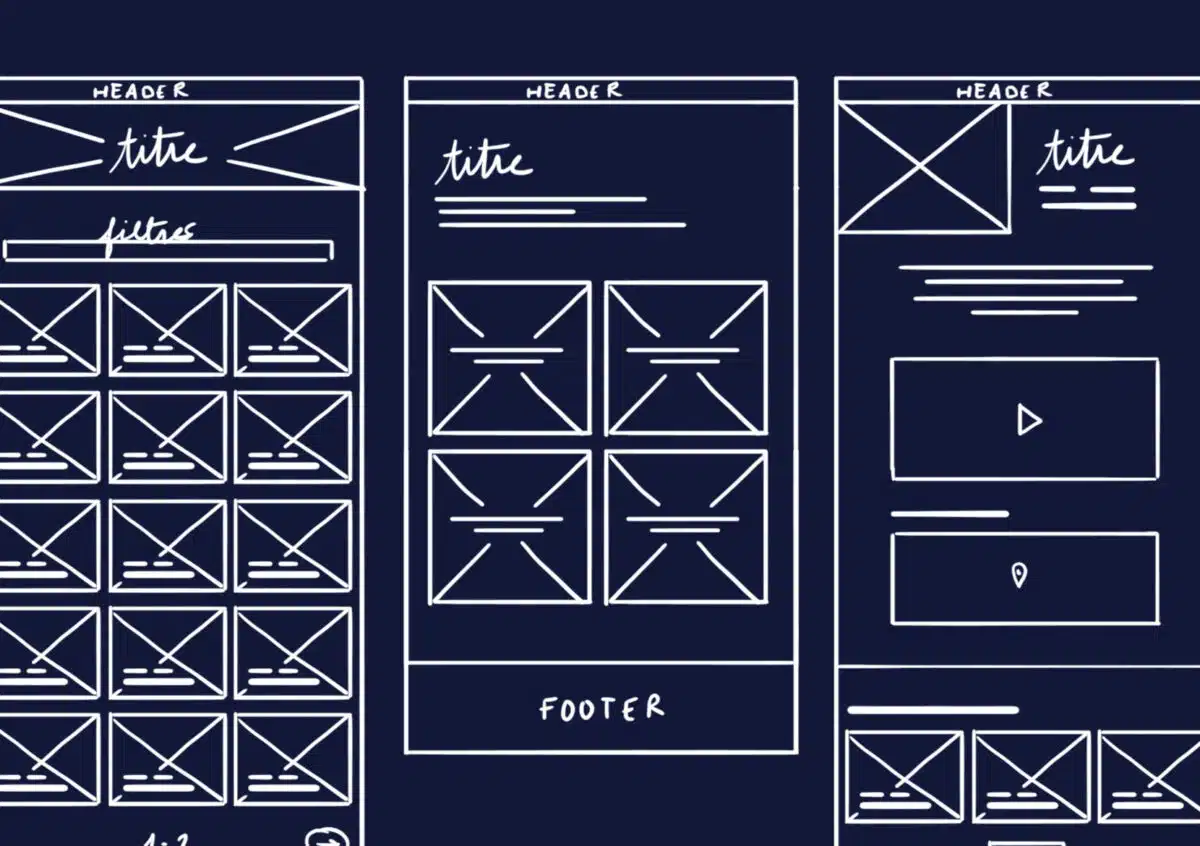
Surcharge
- Définir une structure de page standard contenant des blocs
- Compléter le contenu dans chaque page spécifique en surchargeant des blocs
Structure de base
<!DOCTYPE html>
<html>
<head>
<link rel="stylesheet" href="style.css" />
<title>{% block title %}{% endblock %}</title>
</head>
<body>
{% block body %}{% endblock %}
</body>
</html>
Le block Twig body, vide, est là pour être surchargé.
Spécialisation pour une page
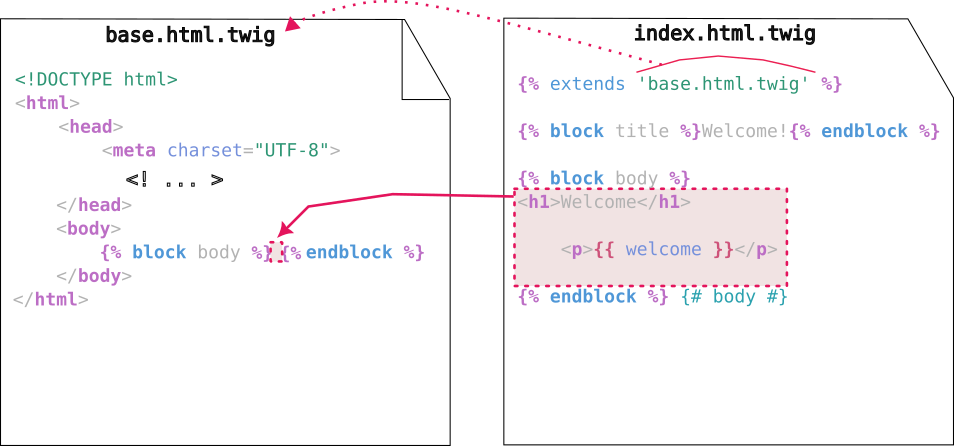
Surcharge : le contenu du bloc body de la page spécialisée index.html.twig se
substitue à celui du gabarit de base.
Mockup exécutables
On peut faire valider l’expérience utilisateur avant de tout coder :
- Conception des maquettes (mockups)
- Codage des templates et CSS
- Validation des interfaces sur un prototype
- Implémentation du reste de l’application
</gabarits>
Plan de la séance
- Génération de pages
- Gabarits (templates)
- Outils Symfony
Coder le MVC
- PHP + Doctrine : Modèle des données
- HTML (+ CSS) + Twig : Vues
- PHP : Contrôleurs (routeur, etc.)
Twig s’interface avec le modèle Doctrine => moins de code à écrire en PHP \o/
Inconvénient : pas mal de syntaxes différentes
Mise au point
- logs
dump()- Data fixtures
- ligne de commande
- barre d’outils Symfony
dump()
En PHP :
$var = [
'a simple string' => "in an array of 5 elements",
'a float' => 1.0,
'an integer' => 1,
'a boolean' => true,
'an empty array' => [],
];
dump($var);

En Twig :
{% dump var %}
Exemple :
{% dump todos %}
{% for todo in todos %}
{% dump todo %}
<a href="/todo/{{ todo.id }}">{{ todo.title }}</a>
{% endfor %}
Barre d’outils
- Requêtes
- Réponses
- Gabarits
- Doctrine
- Performances
- …
Le Rendering Call Graph nous indique quels blocs Twig sont surchargés
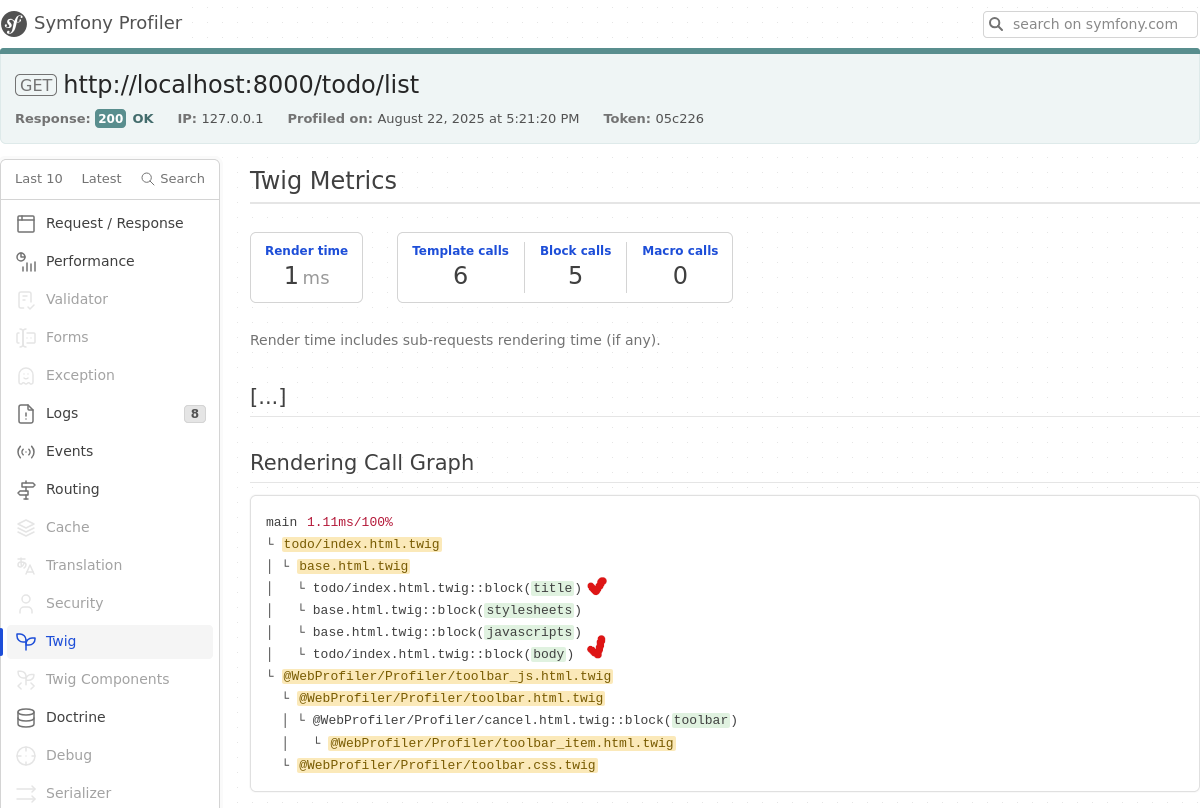
</outils_symfony>
Take away
- HTML
- Modèle, Vues, Contrôleurs
- Gabarits pour mettre en œuvre les Pages (production des pages HTML avec Twig)
- Surcharge des blocs
Récap
[X]HTTP (GET)[X]PHP[X]Doctrine[X]Routeur Symfony[X]HTML[X]Twig
Tout ce qu’il faut pour un site Web dynamique en lecture seule :-)
Postface
Crédits illustrations et vidéos
- illustration patron couture : source : https://textilelearner.net/read-a-sewing-pattern/
- logo Twig © 2010-2017 SensioLabs
- illustration gabarit page : source: https://www.imagescreations.fr/template-wordpress/
Copyright
- Document propriété de ses auteurs et de Télécom SudParis (sauf exceptions explicitement mentionnées).
- Réservé à l’utilisation pour la formation initiale à Télécom SudParis.